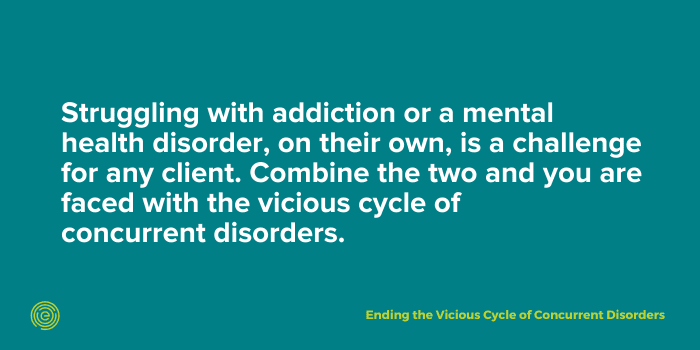By Yvette Brown
What is Concurrent Disorder?
Also known as co-occurring, comorbidity or dual diagnosis disorders, Concurrent Disorder is defined by the World Health Organization as the “co-occurrence of a psychoactive substance use disorder and another psychiatric disorder in the same individual” (Hakobyan et al., 2020; Patel et al., 2021). In Canada, the accepted term is Concurrent Disorder and refers to a non-substance bound mental health disorder and a least one Substance Use Disorder (SUD) in simultaneous need of treatment (Hakobyan et al.).
Concurrent Disorder covers many combinations which can be divided into the following categories:
- Substance use and severe and persistent mental health disorders (i.e., bipolar disorder).
- Substance use and personality disorders (i.e., issues related to anger, aggression impulsivity).
- Substance use and eating disorders (i.e., bulimia).
- Substance use and mood and anxiety disorders (i.e., panic disorders).
- Substance use and mental health disorders (i.e., gambling and sexual disorders).
How Common are Concurrent Disorders?
Concurrent disorders are prevalent in psychiatric samples with 20% of individuals experiencing mental illness also reporting co-occurring substance use. Compared to the general population, within their lifetime, individuals experiencing mental health issues are twice as likely to have a substance use problem (Patel et al.).
Once an individual has developed both disorders, a vicious cycle may be at play where each disorder maintains or even exacerbates the other. This then becomes a self-perpetuating cycle.
Other Risks with Concurrent Disorder
Individuals with concurrent disorders are not only more complex to diagnose and treat; they are also at a higher risk of additional multimorbidity, becoming socially marginalized, having entanglements with the legal system, and subject to stigma (Hakobyan et al.).
Individuals with co-occurring SUD and psychiatric problems are at greater risk for other mental health concerns/issues as well as including suicidality, increased morbidity, domestic violence, increased overall risk of violence, stigma, neurobiological impairment, homelessness, family issues, incarceration, relapse, unemployment, re-hospitalization, social impairment, chronic physical illness, and work instability (Flanagan et al., 2016).
If we look at Anxiety Disorders, with an emphasis on Posttraumatic Stress Disorder (PTSD), we find:
- There is a two to five times higher risk of having issues with alcohol or drugs in people with an anxiety disorder (Canadian Centre on Substance Abuse, 2009).
- Substance dependence (a more problematic and severe issue than substance abuse) is strongly associated with anxiety disorders (Ibid).
- In individuals with both a SUD and an anxiety disorder treating one without also treating the other results in poorer short-term outcomes and high risk for relapse (Ibid).

Anxiety, PTSD, and Concurrent Disorder
Anxiety sensitivity is defined as a fear of physical sensations associated with anxiety and can amplify the intensity of emotional reactions a person experiences; therefore, an individual with PTSD and high anxiety sensitivity may experience fear of trauma reminders compounded by fear of their own anxiety reactions/responses and/or sensations.
Since individuals with PTSD exhibit high levels of anxiety sensitivity which may prompt avoidance of not only the traumatic memories and cues, but any arousal inducing experience (whether this is thoughts, emotions, physiological sensations, or behavioural responses) and may inhibit sensation seeking tendencies resulting in, for example, numbing of emotions, isolation, and social withdrawal (Weiss et al., 2013).
Roughly nine percent of Canadians report having PTSD within their lifetime. Of these individuals that meet the criteria for PTSD, 27.8% report alcohol use/dependence and 25.5% report substance use/dependence (Patel et al.). Within treatment seeking samples, patients with PTSD are 14 times more likely, compared to patients without PTSD, to meet criteria for a SUD.
PTSD is characterized by a variety of symptoms that persist over the months or years following a traumatic event. These symptoms of PTSD are typically categorized into four clusters: intrusive thoughts and memories, avoidance behaviours, negative alterations in cognition and mood (NACM), and alterations in arousal (Ibid).
The Diagnostic and Statistical Manual of Mental Disorders (DSM – V) has expanded the range for the criteria of PTSD to go beyond the fear-based concept and now includes shame, guilt and/or anger — all of which can follow a traumatic event. In PTSD, trauma-related shame and guilt are associated with depression and anxiety symptoms as well as greater levels of PTSD symptoms through treatment.
How are PTSD and Concurrent Disorder Connected?
It is difficult to ascertain the cause of concurrent disorders or whether the SUD or the mental health disorder occurred first. Research, however, has been able to identify mechanisms which could account for associations between PTSD and SUD.
Some of the associations found in research are as follows:
- With the new broader DSM-5 PTSD criteria, alcohol misuse was shown to be significantly associated with arousal, intrusions, NACM symptoms. (Ibid)
- Noticeable association between PTSD, negative emotions and addictions point specifically to the mediation role of negative emotions and the relationship between alcohol use and traumatic symptoms. (Renaud et al., 2021)
- PTSD symptoms’ severity is associated with overall emotion dysregulation within the specific dimensions of difficulties engaging in goal-directed behaviour and controlling impulsive behaviour when upset; limited access to emotion regulation strategies; lack of emotional acceptance and lack of emotional clarity; and with similar associations observed amongst residents in a residential SUD treatment facility who were cocaine dependent. (Weiss et al.)
- Preliminary findings supporting an association between impulsivity and PTSD. (Ibid)
- Research finding negative association between PTSD and sensation seeking which emphasizes the central role of avoidance. Despite the PTSD avoidance criteria describing the avoidance of stimuli associated with the traumatic event, evidence now suggests that individuals with PTSD may also be motivated to avoid other activities that bring about increased arousal states.
- Research findings also suggest that although individuals with PTSD might reflect on the consequences of their behaviours, they may not generally do so when experiencing extreme negative effects or they may, in favour of immediate positive consequences (i.e., emotional relief), simply discount the negative consequences of these behaviours. (Ibid)
Self-medicating for PTSD?
While there are many theories that try to ascertain the reason for co-occurring SUD and PTSD, the Self-Medication Theory has the most empirical support to date. This theory states that “individuals with PTSD incur a heightened risk for substance use and developing SUD due to their propensity to drink alcohol or use drugs to mediate the distressing symptoms and sequelae pf PTSD…studies have supported this demonstrating that PTSD typically emerges before co-occurring SUD as well as evidence indicating that PTSD symptom management is a primary rationale for substance use among individuals with co-occurring SUD and PTSD” (Flanagan et al., 2016).
Although mechanisms of development of concurrent disorders are complex, frequently both disorders share overlapping underlying genetic risk factors, common environmental risk factors in addition to neurobiological pathways (Hakobyan et al.). Given the strong association between PTSD, SUD and emotion dysregulation and that the prefrontal cortex has a major role/impact on emotional regulation through the inhabitation of the amygdala -both PTSD and SUD are both associated with hypo-activation of the prefrontal cortex which could account for the significant emotional dysregulation experienced amongst those with concurrent disorders.
To quote Renaud et al. (2021, p.21): Perturbations of the stress axis could also be implicated in these dual disorders as anomalies of the stress response among subjects with substance use disorders is associated with the activation of extra hypothalamic corticotropin releasing factor (CRF) synthesis, excessively activating the amygdala (brain structure implicated in emotional reactions such as fear). Such hyperactivity has also been associated with the presence of enduring negative emotional states (anxiety, irritability, dysthymia).
While the prefrontal cortex has a major impact on emotional regulation by the inhibition of the amygdala, SUD and PTSD are both associated with a hypoactivation of this area that could explain the major emotional dysregulation among these cases of [concurrent disorder]…[where] a negative emotional state or emotional dysregulation characterized by significant fluctuations in daily life could constitute a clinical feature of these [concurrent disorders] leading to greater craving frequency and/or intensity.
[In addition the impact of early trauma was researched, finding patients with concurrent disorders] and early trauma (<13 years) experienced more severe PTSD symptoms, more craving after exposure, and more severe AUD [alcohol use disorder]. The link with craving intensity could be partially explained by the fact that early trauma lead to deficit in inhibitory control during stress exposure, which might facilitate the use of substances as coping strategy….deficits in inhibition capacities during adolescence is known to be associated with a greater risk of both substance experimentation and the development of SUD.
How to Treat Concurrent Disorders
Traditionally, treatment for concurrent disorders involved sequential or uncoordinated parallel treatment methods. Although now outdated, the majority of organizations and healthcare systems have not moved beyond this to the integrated care models where one clinical team offers mental health and addiction services, simultaneously, within the same setting. Instead, the sequential model (one condition is treated then the other) or the parallel model (each are treated in different places by speciality, e.g., mental health issues in a mental health facility and additions issues treated through addiction services) continue to be utilized (Hakobyan et al.).
Given the complexity, overlapping nature, associations, emotion dysregulation, neurobiological impact, and self-perpetuating cycle of concurrent disorders, specifically in the instance of SUD and PTSD, a comprehensive and global approach is warranted to reduce relapse and improve outcomes.
The integrated model lends itself to this, demonstrating superiority over standard care models (i.e., parallel and sequential models) by improving the mental health and substance use issues in individuals with concurrent disorders and lends itself to being a more cost-effective system.
Integrative treatment approaches for individuals with SUD and PTSD, for example, would include psychotherapies; pharmacological treatment; psychoeducation on addictions and trauma; prolonged exposure, relapse prevention; and various cognitive and emotional regulation modalities such as CPT (Cognitive Processing Therapy); CBT (Cognitive Behavioural Therapy); DBT (Dialectical Behavioural Therapy); ACT (Acceptance and Commitment Therapy).
Together, the simultaneous utilization of these therapies, by one clinical team, would result in managing the overlapping synergistic nature of co-occurring SUD and PTSD ultimately breaking the self-perpetuating cycle of this disorder.
Yvette Brown is a Registered Occupational Therapist, Psychotherapist at EHN Canada’s Bellwood Health Services in Toronto. A therapist whose career spans 15+ years working within community, consultative and clinical/hospital inpatient settings, Brown holds a BSc. and BA from the University of Toronto, a BSc. OT from Queen’s University, and Master of Science in Applied Psychology (MSc.A.Psych.) from University of Liverpool.
References
Back, S., Killeen, T., Badour, C. L., Flanagan, J. C., Allan, N. P., Santa Ana, E., Lozano, B., Korte, K. J., Foa, E. B., and Brady, K. T. (2019). Concurrent Treatment of Substance Use Disorders and PTSD using Prolonged Exposure: A Randomized Clinical Trial in Military Veterans.
Addict. Behav. March: 90, 369-377. Badour, C. L., Gros, D. F., Pericot Valverde, I., Allan, N. P., Flanagan, J. C., Killeen, T., Korte, K., and Back, S.E. (2017). Brief Report: Habituation of Distress and Craving During Treatment as Predictors of Change in PTSD Symptoms and Substance Use Severity. Journal of Consulting and Clinical Psychology, Vol. 85, No. 3, 274-281.
Blakey, S. H., Dillon, K. H., Wagner, H. R., Simpson, J.C., Beckham, J.C., Calhoun, P.S., and Elbogen, E.B. (2022). Psychosocial Well-Being Among Veterans With Posttraumatic Stress Disorder and Substance Use Disorder. Psychological Trauma: Theory, Research, Practice, and Policy, Vol. 14, No. 3, 421-430.
Canadian Centre on Substance Abuse. (2009). Substance abuse in Canada: Concurrent disorders. Ottawa, ON: Canadian Centre on Substance Abuse. Flanagan, J. C., Korte, K. J./, Killeen, T. K., and Back, S. E. (2016). Concurrent Treatment of Substance Use and PTSD. Curr Psychiatry Rep. Vol. 8, No. 8, 70.
Hakobyan, S., Vazirian, S., Lee-Cheong, S., Krausz, M., Honer, W., and Schutz, C. (2020). Concurrent Disorder Management Guidelines. Systematic Review. Journal of Clinical Medicine, 9, 2406.
Lortye, S., Will, J. P., Marquenie, L. A., Goudriaan, A. E., Arntz, A., and de Waal, M. M. (2021). Treating posttraumatic stress disorder in substance use disorder patients with co-occurring posttraumatic stress disorder: study protocol for a randomized controlled trial to compare the effectiveness of different types of timings of treatment. BMC Psychiatry, 21: 442.
Patel, H., Holshausen, K., Oshri, A., Andrews, K., Penta, S., Raymond, H., McKinnon, M., Brasch, J., MacKillop, J., and Amlung, M. (2021). Posttraumatic Stress Disorder Symptomatology and Substance Use in an Outpatient Concurrent Disorder Sample. The Canadian Journal of Psychiatry, Vol. 66, No. 9, 788-797.
Renaud, F., Jakubiec, L., Swendsen, J., and Fatseas, M. (2021). The impact of Co-occurring Post-traumatic Stress Disorder and Substance Use Disorders on Craving: A Systematic Review of the Literature. Frontiers in Psychiatry, Vol. 12, 1-25, 786664.
Tripp, J. C., Haller, M., Trim, R. S., Straus, E., Bryan, C. J., Davis, B. C., Lyons, R., Hamblen, J. L., and Norman, S. B. (2021). Does Exposure Exacerbate Symptoms of Veterans With PTSD and Alcohol Use Disorder? Psychological Trauma: Theory, Research, Practice and Policy, Vol. 3, No. 8, 920-928.
Weiss, N. H., Tull, M. T., Anestis, M. D., and Gratz, K. L. (2013). The Relative and Unique Contributions of Emotion Dysregulation and Impulsivity to Posttraumatic Stress Disorder among Substance Dependent Inpatients. Drug Alcohol Depend, 128(1-20): 45-51.
Zandberg, L. J., McLean, C. P., Rosenfield, D., Powers, M. B., Asnaani, A., and Foa, E. B. (2016). Concurrent Treatment of Posttraumatic Stress Disorder and Alcohol Dependence: Predictors and Moderators of Outcome. Journal of Consulting and Clinical Psychology, Vol. 84, No. 1, 43-56.



